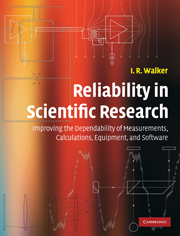 Reliability in Scientific Research
Reliability in Scientific Research Book contents
- Frontmatter
- Contents
- Preface
- List of abbreviations
- 1 Basic principles of reliability, human error, and other general issues
- 2 Mathematical calculations
- 3 Basic issues concerning hardware systems
- 4 Obtaining items from commercial sources
- 5 General points regarding the design and construction of apparatus
- 6 Vacuum-system leaks and related problems
- 7 Vacuum pumps and gauges, and other vacuum-system concerns
- 8 Mechanical devices and systems
- 9 Cryogenic systems
- 10 Visible and near-visible optics
- 11 Electronic systems
- 12 Interconnecting, wiring, and cabling for electronics
- 13 Computer hardware and software, and stored information
- 14 Experimental method
- Index
- References
11 - Electronic systems
Published online by Cambridge University Press: 05 June 2012
- Frontmatter
- Contents
- Preface
- List of abbreviations
- 1 Basic principles of reliability, human error, and other general issues
- 2 Mathematical calculations
- 3 Basic issues concerning hardware systems
- 4 Obtaining items from commercial sources
- 5 General points regarding the design and construction of apparatus
- 6 Vacuum-system leaks and related problems
- 7 Vacuum pumps and gauges, and other vacuum-system concerns
- 8 Mechanical devices and systems
- 9 Cryogenic systems
- 10 Visible and near-visible optics
- 11 Electronic systems
- 12 Interconnecting, wiring, and cabling for electronics
- 13 Computer hardware and software, and stored information
- 14 Experimental method
- Index
- References
Summary
Introduction
The most annoying problems that are encountered during the use of electronic systems are often intermittent in nature. Electromagnetic interference, corona and arcing in high-voltage circuits, and some other causes of potentially intermittent faults, are covered in this chapter. Other reliability problems in electronic hardware, such the failure of high-power equipment, are also discussed below.
Difficulties involving electrical contacts, connectors and cables are very common in electronic work, and frequently intermittent. These are dealt with in Chapter 12. Problems with mains power disturbances and overheating of equipment are considered in Sections 3.6 and 3.4.1, respectively. Vibrations can be a cause of noise in electronic systems in the form of microphonics, and these are discussed in Section 3.5.3. A general survey of some of the causes of intermittent failures in experimental work is presented in Section 3.3.
With some exceptions, details of the design, construction, and troubleshooting of electronic circuits and equipment items (e.g. self-contained electronic instruments) are not discussed in this chapter. Such information is provided in references listed in the “Further reading” section on page 403.
Electromagnetic interference
Grounding and ground loops
General points
Importance of grounding arrangements
Proper grounding is generally necessary for the reliability of electronic systems. This includes both the topology of ground networks, and the quality of the electrical contacts made between ground conductors. (The latter is discussed in Section 12.2.4.) Failure to provide an adequate ground arrangement often leads to erratic noise problems and system malfunctions.
- Type
- Chapter
- Information
- Reliability in Scientific ResearchImproving the Dependability of Measurements, Calculations, Equipment, and Software, pp. 353 - 412Publisher: Cambridge University PressPrint publication year: 2011


